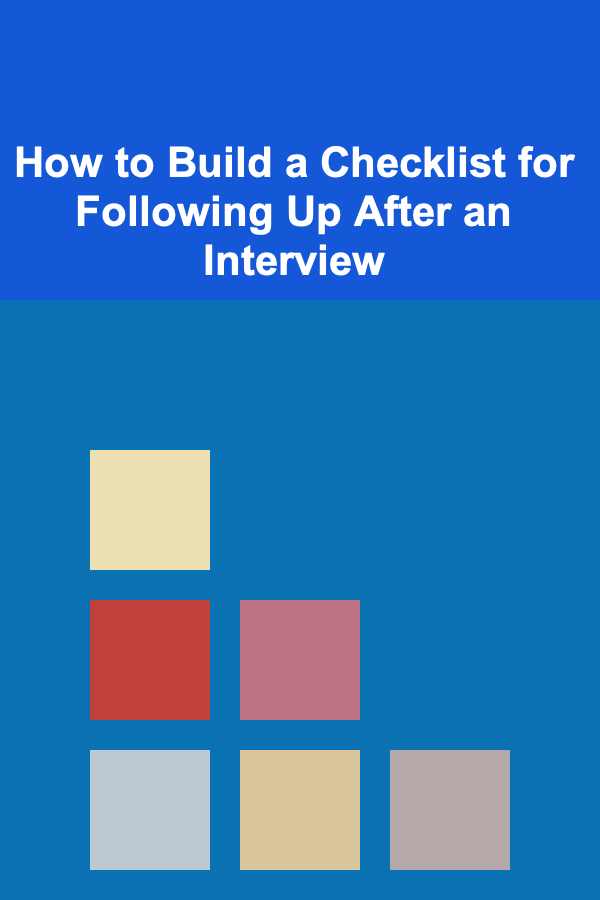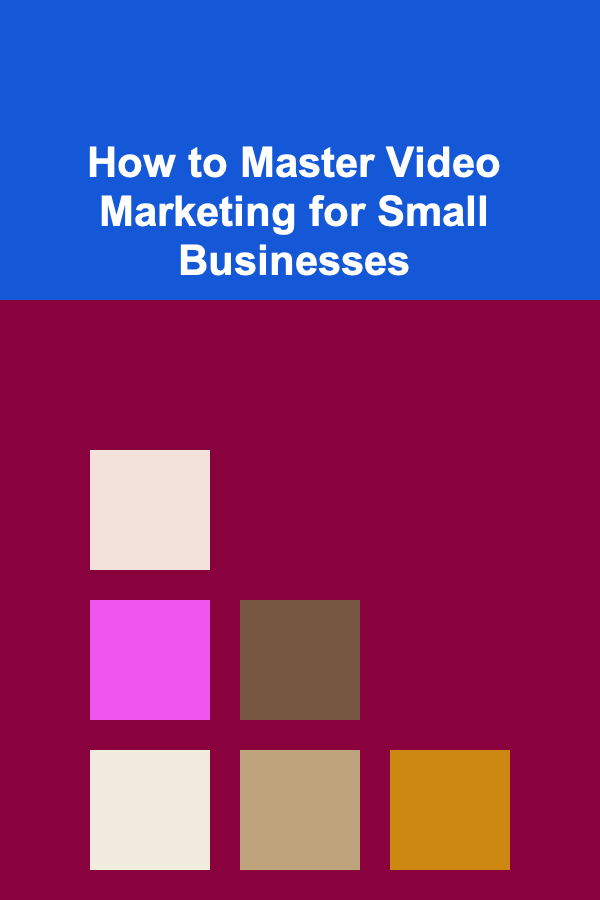
How to Build a Checklist for Following Up After an Interview
ebook include PDF & Audio bundle (Micro Guide)
$12.99$7.99
Limited Time Offer! Order within the next:

After you've completed an interview, one of the most important steps you can take is following up. Many candidates overlook this step, assuming that the process ends as soon as they leave the interview room. However, following up after an interview can set you apart from other candidates, reinforce your interest in the position, and demonstrate professionalism.
Building a checklist for following up after an interview will ensure you're thorough, timely, and consistent in your approach. This actionable guide will take you through all the key points to consider when creating your follow-up checklist, from timing to tone and content.
Timing of Your Follow-Up
One of the most critical aspects of following up is timing. The timing of your follow-up message shows your interest and professionalism, and it can influence how you're perceived by the employer.
a. Send Your Thank-You Note Within 24 Hours
- Why Timing Matters: Sending your thank-you note within 24 hours of the interview is essential. It demonstrates that you are prompt, respectful, and eager. If you wait too long, your message may lose its impact, and it may be seen as a sign of disinterest or lack of professionalism.
- Best Practices: Send your thank-you note in the afternoon or evening of the interview day, ensuring it is delivered within a 24-hour window.
b. Follow-Up on a Non-Decision in 1-2 Weeks
- When to Reach Out: If the employer mentioned a specific timeline for when you would hear back but you haven't received an update, it's appropriate to follow up after 1-2 weeks.
- Why It's Important: Reaching out at this stage shows that you are still interested and allows you to reiterate your enthusiasm. It also gives the employer a gentle nudge without seeming impatient.
Crafting the Perfect Thank-You Note
The thank-you note is your opportunity to express gratitude and reiterate your interest in the position. It's important that your message is both personalized and concise, while also reinforcing why you're a great fit for the role.
a. Personalize Your Message
- Reference Specific Topics: Mention key topics from the interview, such as a project you discussed, a question that sparked your interest, or something unique about the company that aligns with your values. This makes your message stand out and shows that you were actively engaged during the interview.
- Express Enthusiasm: Don't just thank the interviewer; let them know how excited you are about the opportunity. Your enthusiasm can be contagious and may influence their perception of you.
b. Keep It Brief but Meaningful
- Be Concise: A thank-you note doesn't need to be long. Aim for a few paragraphs that express your appreciation for their time, your continued interest in the position, and why you believe you would be an asset to the team.
- Avoid Repetition: While it's important to express gratitude, avoid over-complimenting or reiterating everything you've already discussed during the interview.
c. Be Professional
- Tone and Language: Ensure your tone remains professional, respectful, and sincere. Avoid overly casual language, but also steer clear of sounding robotic. Your thank-you note should be a natural extension of the interview conversation, maintaining the rapport you established.
Follow-Up Email vs. Handwritten Notes
While handwritten notes are thoughtful and can make a lasting impression, they are often impractical in today's fast-paced, digital world. Email has become the most effective way to follow up after an interview.
a. Use Email for Timeliness
- Quick Delivery: Emails can be delivered almost instantly, making them a practical choice if you need to send a timely follow-up. You also ensure that the hiring manager receives your note before making any decisions.
- Professionalism: Email is widely accepted in the business world, and it's less likely to be lost or delayed in transit compared to physical mail.
b. When to Use a Handwritten Note
- Use Sparingly: Handwritten notes can still make an impression, but they should be used selectively. If the interview was exceptionally personal, or if you feel a handwritten note could help you stand out in a small company or in a creative field, consider sending one.
- Follow Up with Email: Even if you send a handwritten note, follow it up with an email to reinforce your gratitude and reiterate your interest in the role.
Polite and Professional Follow-Up After 1-2 Weeks
If the employer gave you a timeline but you haven't heard back after the expected period, it's time to send a polite follow-up email. This follow-up email should not come across as impatient or demanding but should remind the employer of your continued interest.
a. Be Courteous and Respectful
- Thank Them for Their Time: Start by thanking the employer for their time and reiterating your enthusiasm for the role. Keep the tone friendly and respectful.
- Be Direct and Clear: Politely ask for an update on the hiring process. Be specific about the timeline mentioned during the interview and express that you understand they may be busy.
b. Keep It Short and Sweet
- Don't Overload the Email: Keep the follow-up email concise. State your purpose clearly and avoid repeating everything from the interview or in your thank-you note.
- Avoid Over-Personalization: You don't need to rehash your entire history with the company. Keep the message focused on the specific follow-up.
c. Remind Them of Your Value
- Reiterate Your Strengths: Mention a key reason why you're a great fit for the position, based on the interview discussion. This helps keep you top of mind for the hiring manager.
- Stay Positive: Whether or not they have made a decision, remain positive about the opportunity. This shows that you're a team player who is ready to contribute regardless of the outcome.
Handling No Response or Rejection
Sometimes, despite your best efforts, you might not receive a response or may be rejected. While this is disappointing, it's important to handle these situations professionally to leave a positive impression.
a. Send a Polite Thank-You for the Opportunity
- Express Gratitude for the Opportunity: Regardless of the outcome, send a brief email thanking the employer for considering you for the role. Express your continued interest in the company for future opportunities.
- Stay Open to Future Opportunities: If the rejection is based on timing or circumstances, ask if it would be okay to stay in touch for future roles. This shows that you're proactive and can keep the door open for future possibilities.
b. Don't Take It Personally
- Use Rejection as a Learning Opportunity: If you receive feedback, be open to it. Use the information to improve your performance in future interviews.
- Stay Positive and Keep Moving Forward: Rejection is a natural part of the job search process. Maintain a positive attitude and continue to pursue other opportunities.
When to Follow Up Again
In some cases, you may need to follow up more than once, especially if the timeline has passed or if you've been waiting for a decision for a while.
a. Give Sufficient Time
- Be Patient: After your first follow-up email, give the employer enough time to make a decision. Generally, you should wait at least another week or two before following up again.
- Don't Overdo It: Excessive follow-up emails can be seen as pushy or desperate. Keep your emails professional and spaced out to avoid creating a negative impression.
b. Escalate if Necessary
- Contact the Right Person: If your initial contact isn't responding, it may be time to reach out to someone else in the company, such as the hiring manager or HR director. However, only do this if you feel it's appropriate and respectful.
Stay Organized
To manage your follow-up process, it's important to stay organized. Track the companies, roles, and dates of your interviews. This will help you send timely follow-up emails and ensure you don't miss any important deadlines.
a. Create a Spreadsheet
- Use a Simple Tracking System: Create a spreadsheet or use a job search app to track interview dates, follow-up timelines, and any responses from employers. This will help you stay on top of your job search without missing crucial steps.
b. Set Reminders
- Use Calendar Reminders: Set calendar reminders to follow up, ensuring you don't miss your 24-hour thank-you note or a 1-2 week follow-up email.
Conclusion
Building a checklist for following up after an interview is an essential part of the job application process. It allows you to stay organized, professional, and proactive in your approach, giving you an edge over other candidates. By sending timely thank-you notes, following up professionally, and handling rejection gracefully, you create a positive impression that can impact the hiring decision. With the right checklist in place, you ensure that you're not just a strong candidate, but one who is also respectful, organized, and committed to making a great impression.
Other Products

How to Achieve Stunning House Interior Design on a Low Budget
Read More
How to Combine Functionality and Style in Your Renovation
Read More
How to Find Affordable Home Decor Pieces That Look High-End
Read More
How to Identify Your Target Market
Read More
How to Master Video Marketing for Small Businesses
Read More